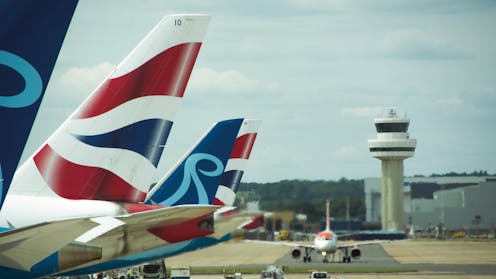A second runway at Gatwick airport could improve efficiency and bring down fares – an economist’s view
- Written by Marwan Izzeldin, Senior Lecturer in Economics, Lancaster University

The £2.2 billion plan for a second runway at London’s Gatwick airport has divided opinion over environmental concerns[1] and its ability to kickstart the economic growth the UK so badly needs. Critics have said that the economic benefits are overstated and the environmental harms unavoidable.
These concerns – including from leading economists[2] – are an important part of the debate. But they don’t tell the whole story. Looking at Gatwick’s northern runway proposal[3] in particular, the evidence[4] suggests that expansion can improve safety, reduce waste and deliver real benefits to travellers and the local community. As long as it is managed responsibly, of course.
Gatwick is Europe’s busiest single-runway airport[5], handling more than 43 million passengers a year and around 260,000 aircraft movements on just one operational runway.
This creates bottlenecks – during peak hours, aircraft go into “holding stacks” (vertical formations of planes that circle until it’s their turn to land). A typical Boeing 737[6] burns 2.5 to three tonnes of jet fuel per hour, so just 15 minutes of unnecessary holding adds nearly a tonne of CO₂ emissions into the atmosphere.
With an average of 3.24 minutes[7] lost per flight into Gatwick in holding stacks and to other inefficiencies, the waste is significant, both environmentally and economically. Economists call this a “congestion externality”. That is, costs imposed on society with no corresponding benefit. Adding runway capacity directly reduces these inefficiencies.
Critics argue that more flights automatically mean more emissions. Yet the data show that efficiency[8] matters too. Absorbing delays at cruise altitude rather than in low-level holding stacks has been shown to cut waste[9] significantly.
At Gatwick, an arrival management scheme introduced in 2019 was expected to save more than 26,000 minutes[10] of holding per year. If realised, this would translate into around 1,200 tonnes of fuel and 3,800 tonnes of CO₂ avoided annually.
Pairing those measures with the northern runway – which reduces stacking – compounds the savings. In welfare terms, this is a clear case of lowering emissions intensity per movement[11] (a more useful measure than a company’s overall emissions). It should ensure that growth is not just about more traffic but also cleaner, more efficient traffic.
There are also important consumer benefits. Gatwick competes heavily in the leisure and short-haul market, where families are most sensitive to price. By expanding to two runways, airlines will be able to schedule more services at peak times, bringing down fares.
Research shows that a scarcity of slots adds a premium to air fares[12]. At Europe’s busiest airports – which include Gatwick – it’s estimated that by 2035 congestion will add €10.42 (£9.10) on average[13] to each ticket.
Expansion also supports local and national economies. Gatwick forecasts[14] that the northern runway project could create 14,000 jobs[15] and contribute nearly £1 billion[16] a year to the regional economy.
These jobs span construction, airport operations, tourism and supply chains, directly benefiting communities in the south-east of England. It’s what economists call a distributional gain – the benefits are spread broadly through employment and regional growth, rather than to a narrow group.
Of course, the costs – noise, air quality and climate – cannot be ignored and will have to be managed. Expansion plans retain the strict 11pm-6am night flight quota, implement quieter continuous descent operations (a technique that allows planes to descend more smoothly, creating less noise), and aim to encourage more travellers to arrive at the airport by rail.
Around 44% of Gatwick passengers[17] already arrive by train, and it has more direct train connections[18] than any other European airport.
With timetable integration and new fare types, Gatwick aims to push the percentage of passengers arriving and leaving by rail well above 50%. This would cut road traffic emissions. It is an attempt to ensure that those who generate environmental costs (airlines and airports) also bear responsibility for reducing them.
The real test is not whether Gatwick grows, but how it grows. With verifiable baselines – such as average stack minutes per arrival, go-around rates (where pilots abandon a landing attempt and circle back), and CO₂ per movement – expansion can be monitored and airport bosses held to account.
If the promised gains are delivered, the net effect could include safer skies, lower emissions intensity, cheaper fares, more jobs and stronger regional growth. Welfare economics teaches us that policy should maximise the wellbeing of the many, not preserve the convenience of a few. By that measure, Gatwick’s northern runway expansion could well be a welfare-enhancing choice.
References
- ^ environmental concerns (theconversation.com)
- ^ leading economists (neweconomics.org)
- ^ northern runway proposal (www.gatwickairport.com)
- ^ the evidence (www.gov.uk)
- ^ busiest single-runway airport (www.gatwickairport.com)
- ^ typical Boeing 737 (aviex.goflexair.com)
- ^ 3.24 minutes (www.eurocontrol.int)
- ^ efficiency (www.sciencedirect.com)
- ^ cut waste (www.researchgate.net)
- ^ 26,000 minutes (www.nats.aero)
- ^ emissions intensity per movement (carbonbetter.com)
- ^ premium to air fares (www.atceuc.org)
- ^ €10.42 (£9.10) on average (www.atceuc.org)
- ^ Gatwick forecasts (www.gatwickairport.com)
- ^ 14,000 jobs (infrastructure.planninginspectorate.gov.uk)
- ^ nearly £1 billion (infrastructure.planninginspectorate.gov.uk)
- ^ 44% of Gatwick passengers (www.air-uk.net)
- ^ direct train connections (www.gatwickairport.com)
- ^ Dinendra Haria/Shutterstock (www.shutterstock.com)







